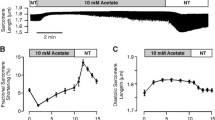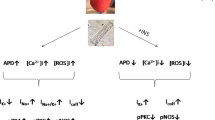Abstract
BMS309403, a substance used as an inhibitor of adipocyte fatty acid-binding protein, has been suggested as a new therapeutic agent for treating type 2 diabetes mellitus and atherosclerosis; however, little is known about its possible side effects. The present study investigates the effects of BMS309403 on the cardiovascular system. We used isolated perfused heart preparations and single cardiomyocytes from adult rats for contractile analysis. The Ca2+ sensitivity of the myofilaments was investigated by using porcine cardiac skinned muscle fibers. BMS309403 induced a negative effect on the contractility of isolated perfused hearts leading to heart arrest without interfering in the electrocardiographic activity, suggesting electromechanical dissociation. Experiments with isolated cardiomyocytes showed that BMS309403 had a direct biphasic inhibitory effect on cardiomyocyte contraction, at higher concentrations by attenuating Ca2+ levels. This negative inotropic effect does not result from a direct effect on the myofilaments. BMS309403 has an acute cardiac depressant effect in vitro. The potential therapeutic applicability of this compound requires additional consideration.






Similar content being viewed by others
Abbreviations
- ApoE:
-
Apolipoprotein E
- BDM:
-
Butanedione monoxime
- CF:
-
Coronary flow
- ECG:
-
Electrocardiogram
- FABP3:
-
Heart isoform of FABP
- FABP4:
-
Adipocyte fatty acid-binding protein
- FABP5:
-
Epidermal isoform of FABP
- FABPs:
-
Fatty acid-binding proteins
- HBSS:
-
Hank's balanced salts solution
- HR:
-
Heart rate
- KHS:
-
Krebs-Henseleit solution
- LVP:
-
Left ventricular pressure
- m HA :
-
Median heart arrest time
- m IC :
-
Median irregular contraction time
- SERCA:
-
Sarcoplasmatic reticulum Ca2+ ATPase
References
Baker LC, Wolk R, Choi BR, Watkins S, Plan P, Shah A, Salama G (2004) Effects of mechanical uncouplers, diacetyl monoxime, and cytochalasin-D on the electrophysiology of perfused mouse hearts. Am J Physiol Heart Circ Physiol 287:H1771–H1779
Baxa CA, Sha RS, Buelt MK, Smith AJ, Matarese V, Chinander LL, Boundy KL, Bernlohr DA (1989) Human adipocyte lipid-binding protein: purification of the protein and cloning of its complementary DNA. Biochemistry 28:8683–8690
Bers DM, Berlin JR (1995) Kinetics of [Ca]i decline in cardiac myocytes depend on peak [Ca]i. Am J Physiol 268:C271–C277
Binas B, Danneberg H, McWhir J, Mullins L, Clark AJ (1999) Requirement for the heart-type fatty acid binding protein in cardiac fatty acid utilization. FASEB J 13:805–812
Furuhashi M, Hotamisligil GS (2008) Fatty acid-binding proteins: role in metabolic diseases and potential as drug targets. Nat Rev Drug Discov 7:489–503
Furuhashi M, Tuncman G, Gorgun CZ, Makowski L, Atsumi G, Vaillancourt E, Kono K, Babaev VR, Fazio S, Linton MF, Sulsky R, Robl JA, Parker RA, Hotamisligil GS (2007) Treatment of diabetes and atherosclerosis by inhibiting fatty-acid-binding protein aP2. Nature 447:959–965
Gwathmey JK, Hajjar RJ, Solaro RJ (1991) Contractile deactivation and uncoupling of crossbridges. Effects of 2,3-butanedione monoxime on mammalian myocardium. Circ Res 69:1280–1292
Hertzel AV, Bernlohr DA (2000) The mammalian fatty acid-binding protein multigene family: molecular and genetic insights into function. Trends Endocrinol Metab 11:175–180
Lamounier-Zepter V, Ehrhart-Bornstein M, Karczewski P, Haase H, Bornstein SR, Morano I (2006) Human adipocytes attenuate cardiomyocyte contraction: characterization of an adipocyte-derived negative inotropic activity. FASEB J 20:1653–1659
Lamounier-Zepter V, Look C, Alvarez J, Christ T, Ravens U, Schunck WH, Ehrhart-Bornstein M, Bornstein SR, Morano I (2009) Adipocyte fatty acid-binding protein suppresses cardiomyocyte contraction: a new link between obesity and heart disease. Circ Res 105:326–334
Lee MY, Li H, Xiao Y, Zhou Z, Xu A, Vanhoutte PM (2010) Chronic administration of BMS309403 improves endothelial function in apolipoprotein E-deficient mice and in cultured human endothelial cells. Br J Pharmacol 162:1564–1576
Lehmann F, Haile S, Axen E, Medina C, Uppenberg J, Svensson S, Lundback T, Rondahl L, Barf T (2004) Discovery of inhibitors of human adipocyte fatty acid-binding protein, a potential type 2 diabetes target. Bioorg Med Chem Lett 14:4445–4448
Look C, Morano I, Ehrhart-Bornstein M, Bornstein SR, Lamounier-Zepter V (2010) Adipocyte-derived factors suppress heart contraction. Int J Obes (Lond) 35:84–90
Marr E, Tardie M, Carty M, Brown Phillips T, Wang IK, Soeller W, Qiu X, Karam G (2006) Expression, purification, crystallization and structure of human adipocyte lipid-binding protein (aP2). Acta Crystallogr Sect F Struct Biol Cryst Commun 62:1058–1060
Ringom R, Axen E, Uppenberg J, Lundback T, Rondahl L, Barf T (2004) Substituted benzylamino-6-(trifluoromethyl)pyrimidin-4(1H)-ones: a novel class of selective human A-FABP inhibitors. Bioorg Med Chem Lett 14:4449–4452
Ruegg JC, Zeugner C, Van Eyk J, Kay CM, Hodges RS (1989) Inhibition of TnI-TnC interaction and contraction of skinned muscle fibres by the synthetic peptide TnI [104–115]. Pflugers Arch 414:430–436
Sulsky R, Magnin DR, Huang Y, Simpkins L, Taunk P, Patel M, Zhu Y, Stouch TR, Bassolino-Klimas D, Parker R, Harrity T, Stoffel R, Taylor DS, Lavoie TB, Kish K, Jacobson BL, Sheriff S, Adam LP, Ewing WR, Robl JA (2007) Potent and selective biphenyl azole inhibitors of adipocyte fatty acid binding protein (aFABP). Bioorg Med Chem Lett 17:3511–3515
Veerkamp JH, Peeters RA, Maatman RG (1991) Structural and functional features of different types of cytoplasmic fatty acid-binding proteins. Biochim Biophys Acta 1081:1–24
Acknowledgments
We gratefully acknowledge the expert technical assistance of Petra Sakel. We thank Kathleen Eisenhofer for proofreading of this paper. This study was supported by the “Kompetenznetz Adipositas (Competence Network for Obesity)” funded by the German Federal Ministry of Education and Research (grant number 01GI0833).
Conflicts of interest
None.
Author information
Authors and Affiliations
Corresponding author
Rights and permissions
About this article
Cite this article
Look, C., Morano, I., Ehrhart-Bornstein, M. et al. BMS309403 directly suppresses cardiac contractile function. Naunyn-Schmiedeberg's Arch Pharmacol 384, 255–263 (2011). https://doi.org/10.1007/s00210-011-0667-1
Received:
Accepted:
Published:
Issue Date:
DOI: https://doi.org/10.1007/s00210-011-0667-1




